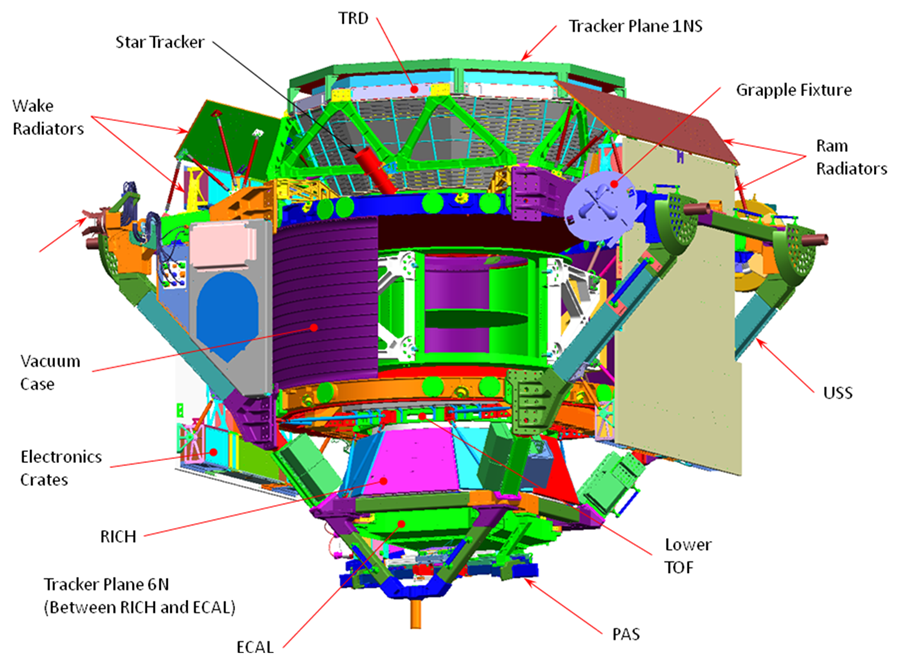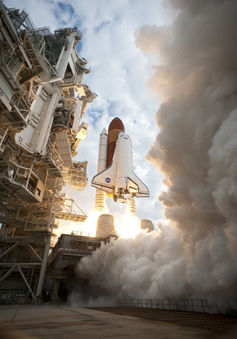New light on dark matter: space station magnet attracts praise


Nobel prizewinner Samuel Ting, early Thursday morning (March 4, 2:00 AEDT), announced the first results from the Alpha Magnetic Spectrometer (AMS) search for dark matter. The findings, published in Physical Review Letters, provide the most compelling direct evidence to date for the existence of this mysterious matter.
In short, the AMS results have shown an excess of antimatter particles within a certain energy range. The measurements represent 18 months of data from the US$1.5 billion instrument.
The AMS experiment is a collaboration of 56 institutions, across 16 countries, run by the European Organisation for Nuclear Research (CERN). The AMS is a giant magnet and cosmic-ray detector complex fixed to the outside of the International Space Station (ISS).
Dark matter matters
The visible matter in the universe, such as you, me, the stars and planets, adds up to less than 5% of the universe. The other 95% is dark, either dark matter or dark energy. Dark matter can be observed indirectly through its interaction with visible matter but has yet to be directly detected.
Cosmic rays are charged high-energy particles that permeate space. The AMS is designed to study them before they have a chance to interact with Earth’s atmosphere.

An excess of antimatter within the cosmic rays has been observed in two recent experiments – and these were labelled as “tantalising hints” of dark-matter decay.
One possibility for the excess antimatter, predicted by a theory known as supersymmetry, is that positrons (antimatter electrons) could be produced when two particles of dark matter collide and annihilate.
Assuming that dark matter is evenly distributed, these theories predict the newly reported observations.
But the AMS measurement cannot yet entirely rule out the alternative explanation that the positrons originate from pulsars (rotating neutron stars) distributed around the galactic plane.
Supersymmetry theories also predict a cut-off at higher energies above the mass range of dark matter particles, and this has not yet been observed. Over the coming years, the AMS will further refine the measurement’s precision, and clarify the behaviour of the positron fraction at higher energies.
Ting’s thing
The AMS idea dates back to 1994. At that time NASA was desperate to develop a “sexy” science project that would endear the US scientific community to the ISS.

Enter Ting and his idea of a space-borne magnet that would sift matter and antimatter.
By 1995 Ting had NASA’s agreement. The US Department of Energy would fund the detector, and NASA would provide space on the ISS and a shuttle to fly it there. Ting would obtain the foreign involvement needed to build the instrument.
By 2008 the detector was complete but the shuttle flight schedule was a shambles. With delays after the 2003 Columbia disaster and the probable 2010 retirement of the shuttles, no flights were available to deliver the device to the space station.
Ting persisted and, through lobbying, got Congress to authorise one more shuttle flight, STS-134 – the second last ever.
On May 16, 2011 the final flight of NASA’s youngest shuttle, Endeavour, the spectrometer was launched. It has been in operation and collecting data since June 27, 2011 and has an expected operational lifetime in excess of 10 years.
Antimatter matters
There is a second scientific aim of the AMS. Experimental evidence indicates that our galaxy is made of matter. But the Big Bang theory assumes equal amounts of matter and antimatter were present at the origin of the universe.
So what happened to all the antimatter? The observation of just one antihelium nucleus would provide evidence for the existence of a large amount of antimatter somewhere in the universe.
With a sensitivity three orders of magnitude better than previous experiments, the Alpha Magnetic Spectrometer will be searching for the existence of this primordial antimatter.
Amazingly we have come to recognise that we know little about what makes up 95% of our universe.
Today’s AMS results mark a precision start to an audacious experiment to redress that ignorance.
Kevin Orrman-Rossiter does not work for, consult to, own shares in or receive funding from any company or organisation that would benefit from this article, and has no relevant affiliations.
![]()
This article was originally published at The Conversation.
Orrman-Rossiter K (2013-04-10 00:02:01). New light on dark matter: space station magnet attracts praise. Australian Science. Retrieved: Dec 07, 2025, from https://ozscience.com/physics/new-light-on-dark-matter-space-station-magnet-attracts-praise/
 Follow
Follow
1 thought on “New light on dark matter: space station magnet attracts praise”
Comments are closed.